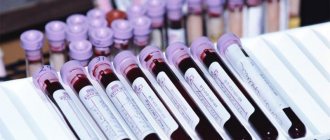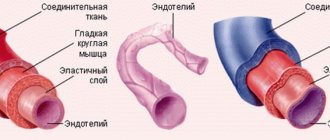Coagulogram, expanded
Coagulogram, extended - a set of indicators of the blood coagulation system, recommended during pregnancy, recurrent miscarriage and for patients with a high risk of developing complications from the hemostatic system (blood coagulation). Normally, the body constantly maintains a balance of blood coagulation and anticoagulation systems. Pregnancy is a period when multiple restructuring of the hemostatic system occurs, because blood flow in the placenta is formed, hormonal levels change and the body strengthens coagulation factors (physiological hypercoagulation) to avoid the consequences of bleeding during childbirth.
What is included in the complex?
Mandatory screening indicators:
- APTT
- Prothrombin (time, according to Quick, INR)
- Thrombin time
- Fibrinogen
Antithrombin III is a natural anticoagulant; its decrease is one of the reasons for recurrent miscarriage and fetal death.
D-dimer is a marker of fibrin breakdown (fibrinolysis. Used to monitor pregnant women over time.
Lupus anticoagulant, screening - used to diagnose antiphospholipid syndrome, the onset of which is often observed during pregnancy, causing miscarriage and other complications.
In what cases is the Coagulogram complex, expanded, prescribed?
- In case of a normal pregnancy and the absence of risk factors, once, then according to the decision of the attending physician.
- In case of complicated pregnancy and/or the presence of risk factors - repeatedly, monitoring over time (decided by the attending physician)
- Patients with miscarriage
- Dynamic observation and assessment of the effectiveness of therapy in patients with cardiovascular diseases and the risk of developing thrombosis
What do the test results mean?
The result reflects the parameters of the hemostatic system at the time of the study, so influencing factors should be taken into account and monitored over time if there are deviations.
The interpretation is carried out by a qualified doctor, taking into account data from the anamnesis, examination and other research methods.
Test deadlines.
Extended coagulogram is prepared within 1-2 days
How to prepare for the analysis?
Blood is donated strictly in the morning, on an empty stomach (at least 8 hours of fasting) while observing the drinking regime. It is necessary to indicate the anticoagulants taken by the patient, NSAIDs (non-steroidal anti-inflammatory drugs - paracetamol, aspirin, Nurofen, diclofenac, etc.), oral contraceptives, antibiotics. No special preparation is needed.
Indications
A hemostasiogram is prescribed to expectant mothers 2-3 times before birth without fail. Indications for additional blood testing for coagulation are:
- increased uterine tone;
- varicose veins of the lower extremities, anus, esophageal veins;
- a history of miscarriages or miscarriages of pregnancies at different stages;
- diseases of the liver and kidneys that lead to disruption of their function;
- the presence of bad habits in a woman, which increases the risk of developing complications in the blood clotting function;
- presence of blood diseases in the family - hemophilia, thrombosis, varicose veins;
- frequent nosebleeds;
- autoimmune diseases;
- cardiovascular diseases;
- multiple pregnancy;
- fetoplacental insufficiency, late gestosis, intrauterine growth retardation;
- pregnancy resulting from IVF.
Preparation for a hemostasiogram
Blood is drawn from a vein on an empty stomach - that is, the patient’s last meal should be 8-12 hours before the procedure. In the morning before the analysis, you can drink some pure still water. On the eve of the test, you should avoid stress, physical and mental fatigue, and do not drink alcohol. Do not smoke for at least 2 hours before taking blood.
Biomaterial should not be submitted for analysis earlier than 3-5 days after ultrasound, x-rays or physical procedures.
If it is necessary to monitor indicators over time, subsequent studies should be carried out under identical conditions: in the same laboratory, at the same time of day, etc.
Important! A few days before the test, you need to stop taking medications, especially those that affect clotting (for example, aspirin). If the patient takes such drugs on a regular basis, it is necessary to discuss this issue with the attending physician!
It is not advisable for women to undergo screening during menstruation - real data on hemostasis during this period may be distorted.
How to take a hemostasiogram
A hemostasiogram is a comprehensive study of the hemostatic system, or blood coagulation system. This analysis allows us to identify the patient’s existing violations of this system in order to correct them in a timely manner. Blood clotting is a protective mechanism that is needed to prevent blood loss. Pathology of the blood coagulation system can manifest itself in two variants: hypercoagulation and hypocoagulation .
With hypercoagulation, substances that cause blood coagulation and clot formation become more active and their quantity exceeds the norm. This leads to the formation of clots in the bloodstream. Thrombosis develops - conditions in which there is a danger to the patient’s life. The opposite situation - hypocoagulation - threatens blood loss, since in this case the level of coagulation factors in the blood is reduced and they do not fully perform their functions, which leads to increased bleeding. A hemostasiogram can be screening or detailed.
A screening hemostasiogram is carried out in order to draw a conclusion about the state of the coagulation system and the presence or absence of hemostasis pathology.
When performing a screening hemostasiogram, the following blood parameters are determined:
- prothrombin
- prothrombin time
- thrombin time
- APTT (activated partial thrombin time)
- INR (international normalized ratio)
- fibrinogen
- peripheral blood platelet count.
A screening hemostasiogram is usually prescribed before elective surgery during pregnancy.
A detailed hemostasiogram is performed for patients in whom the doctor has suspected some specific hemostasis disorder based on complaints and clinical data, or pathological results were obtained during a screening hemostasiogram. Sometimes pregnant women may need such an analysis.
It includes parameters such as D - dimer , RFMC (soluble fibrin - monomer complexes), antithrombin III, lupus anticoagulant, and, if necessary, plasma coagulation factors and the results of platelet aggregation with various aggregates. In addition, a distinction is made between aggregation hemostasis - its study allows one to evaluate the ability of platelets to aggregate - and coagulation hemostasis, which includes studies of plasma coagulation factors.
It is important to properly prepare for a hemostasiogram study
The patient must come to the test on an empty stomach.
Fasting means that at least 12 hours have passed from the last meal to the analysis. The day before the study, physical and psycho-emotional stress should be excluded. It is necessary to refrain from drinking alcohol one day before the test, and from smoking at least an hour before taking blood. It is advisable for women to study hemostasis outside of menstruation.
Blood is taken from a vein in the elbow. It is better if blood is taken in the early morning hours, then the reliability of the analysis is higher.
The accuracy of the analysis is greatly influenced by the blood collection procedure itself. Currently, an increasing number of laboratories are switching to vacuum blood collection systems. This is convenient, as it ensures high accuracy of dosing and the ratio of blood and reagent volumes. After drawing, the tube with blood must be turned up and down 3-4 times so that the blood is well mixed with the reagent, but do not shake.
If blood is taken with a regular syringe, it is important that it flows into the tube by gravity, without vigorous aspiration. Otherwise, hemolysis , that is, destruction of blood cells, may occur. Hemolyzed blood cannot be tested, in which case the blood draw will have to be repeated. The interpretation of the hemostasiogram results should be carried out by a physician.
Decoding indicators
When deciphering a hemostasiogram, the specialist pays attention to the following indicators:
- APTT is the period of time during which a blood clot forms when a special reagent is added. Normally, this time should not exceed 20 seconds.
- Fibrinogen is a special protein that, during reactions, turns into fibrin and forms a blood clot. Normally up to 6.5 g/l.
- Platelets are blood cells involved in the formation of blood clots. Normal is 131-402 thousand/µl.
- Lupus anticoagulant is a group of proteins that appear in the blood when the immune system is malfunctioning. Normally they should not be detected.
- Prothrombin is a blood clotting protein. Normal is 78-141%.
- Thrombin time is the period of time during which a blood clot forms. Normally it does not exceed 25 seconds.
- Antithrombin is a protein of the blood coagulation system. Normal is 70-110%.
- D-dimer is a special substance formed after the breakdown of fibrin, which is part of a blood clot. Normal values vary depending on the duration of pregnancy - from 33 to 900 ng/ml in the first half of pregnancy and from 900 to 1500 ng/ml in the second half.
The analysis indicators are deciphered by a gynecologist who knows the peculiarities of the woman’s pregnancy; according to indications, a consultation is held with a hemosthesiologist.










